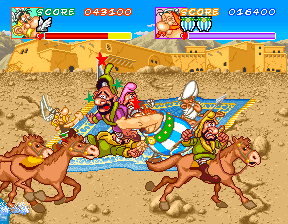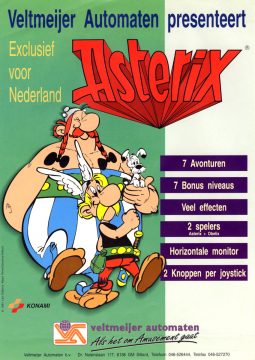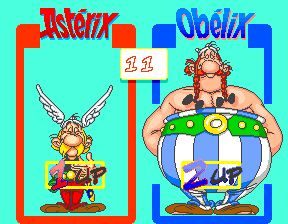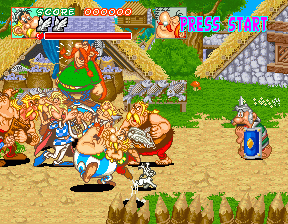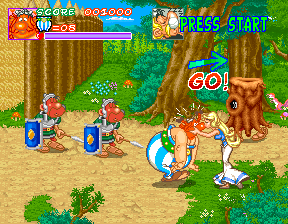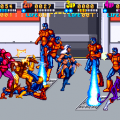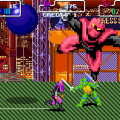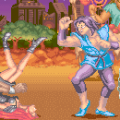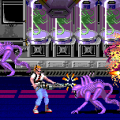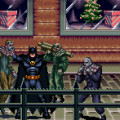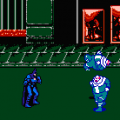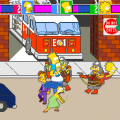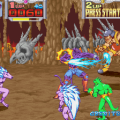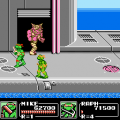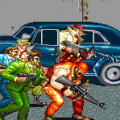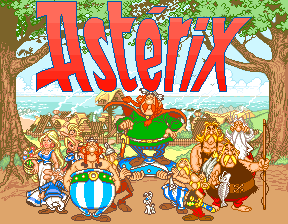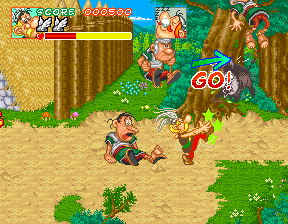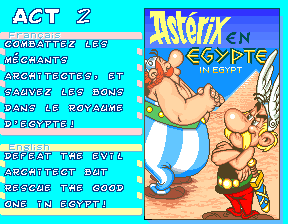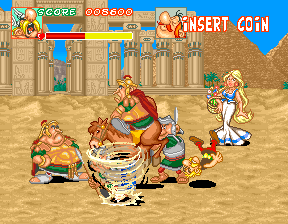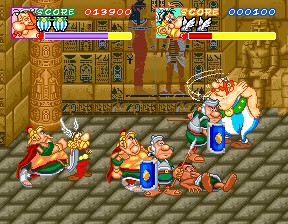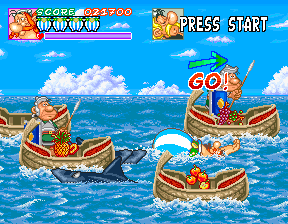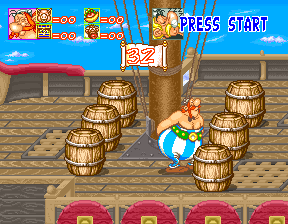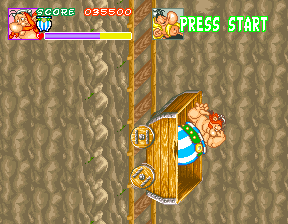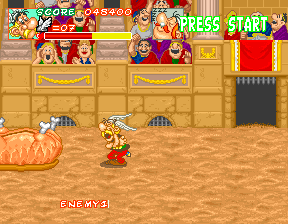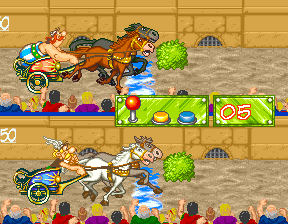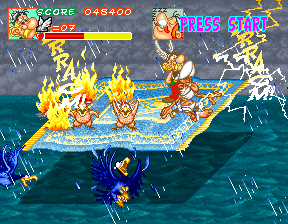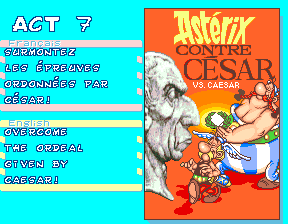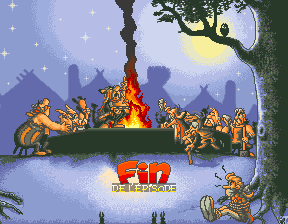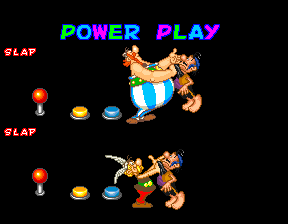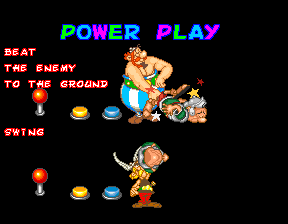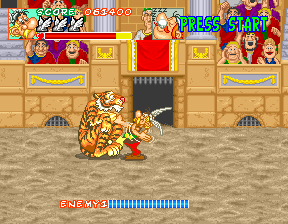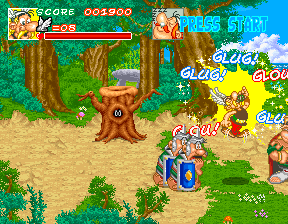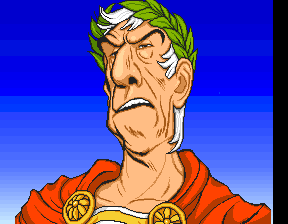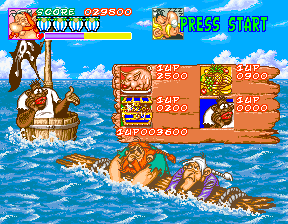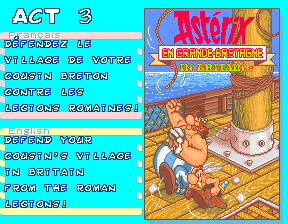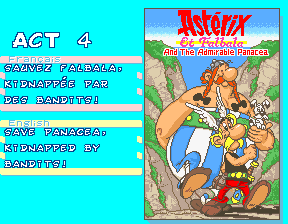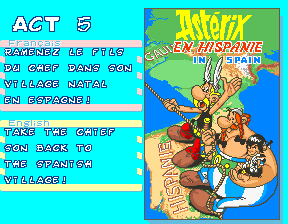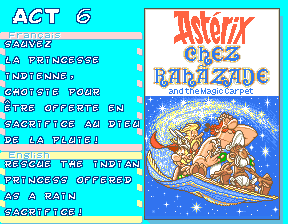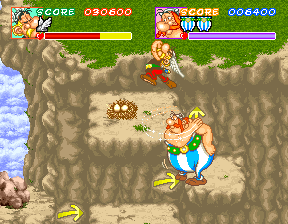- Asterix (Introduction)
- Astérix / Taz (Atari 2600)
- Obelix
- Asterix and the Magic Potion
- Asterix and Obelix: The Odyssey
- Asterix and the Magic Cauldron
- Asterix at Rahàzade
- Asterix: Operation Getafix
- Astérix (Arcade)
- Astérix (SMS)
- Astérix (NES/GB/SNES)
- Astérix and the Great Rescue
- Astérix and The Secret Mission
- Astérix and the Power of Gods
- Asterix: Caesar’s Challenge
- Astérix & Obélix: Die Suche nach dem Schwarzen Gold
- Astérix & Obélix Take on Caesar
- Astérix: Search for Dogmatix
- Astérix: The Gallic Wars
- Astérix Mega-Madness
- Asterix & Obélix Bash Them All
- Astérix & Obélix
- Astérix & Obélix XXL
- Astérix & Obélix XXL 2
- Astérix at the Olympic Games
- Astérix & Obélix Encounter Cleopatra
- Astérix: These Romans Are Crazy!
- Astérix: Rescue Obélix / Astérix and the Vikings / Astérix and Cleopatra
In 1990 Astérix was finally out of the stranglehold of Coktel Vision’s mediocre attempts, which time and time again felt stiff and unappealing. It was time to find a new home and a fresh take on the series. Luckily for Astérix, his new home would be one that knew exactly what to do with him.
During the late ’80s to the early ’90s, licensed properties had become a hot commodity. Franchises like Star Wars had for years proven that kids would pretty much die for anything with the likeness of their favorite characters or logos on it, and video games were no exception. For the most part these games were quick cash-ins which would sometimes have little to no clear similarity to the licenses it was based on, but Japanese developers such as Capcom, Konami and Sunsoft had acquired hot properties and put great efforts into the games they developed for them. Capcom had managed to snag the most valuable property of all, Disney, which led Konami to go on a hunt for other popular shows at the time to tie their name to. While the most famous of these titles would in the end be Teenage Mutant Ninja Turtles and The Simpsons, Konami would also manage to sign Astérix. This combination would turn to be a match made in heaven.
Astérix is a scrolling beat-em-up which takes the duo of Astérix and Obélix through all their most famous adventures. Running on the same engine as TMNT: The Arcade Game, Astérix offers some non stop action, with Roman soldiers being in seemingly never ending supplies and famous henchmen and villains making appearances at near every step you take. The style of game is a perfect fit for Astérix. The main draw of each comic and each movie was Astérix going on long journeys to beat up the bad guys, and all the humorous fights that would take place before reaching the main baddy. Konami didn’t just throw this game quickly together, they really did their homework and the end result is that every character is represented authentically and never having a single questionable moment in the eyes of the fans. The graphics are probably the most colorful out of all the beat-em-ups that Konami would release and the art style is near identical to the artwork of Albert Uderzo, doing a better job at representing the product’s look than the already stellar Ninja Turtles titles out. The animations, facial expressions and overall tone is faithfully represented, as Roman soldiers will fly into the air, lose teeth, get bruised and crawl out of the screen as our heroes run through them. After beating them, you can even collect their helmets for extra points. The main generic bad guys are the stock Roman soldiers and fat centurions, but as you progress onto the other levels you’ll also find yourself fighting pirates, thieves and Indian guards. Astérix and Obélix have a plethora of moves at their disposal between them which is shown during the attract mode along with the controls, with one of the grabs being the iconic face slapping seen in Astérix et Cléopâtre (Asterix and Cleopatra)
All the central characters make an appearance, some with special purposes. When you start the game, you will see all the villagers cheering you and fighting each other as they seem to be unnerved by the impending Roman forces outside of town. Panoramix will alert the players of Idéfix’s arrival into the scene where he will bring along either a bottle of magic potion for Astérix or a roasted wild boar for Obélix. These items will instantly take out all enemies onscreen. At certain times you will also find Falbala walking around picking flowers. If the player gets in contact with her, they will receive a kiss which refills half your energy bar. At all these events, the enemies around you will actually react with either fear from your magic potion or jealousy of the kiss, further enhancing the presentation of the Astérix spirit found in the books and movies.
The levels are each based on different books in the Astérix series and contain signature places or objects from them, like the pyramids of Egypt, the flying carpet in India and the Circus in Rome. What really sets this game apart from the other similar games at the time are the level designs. Whereas TMNT and Final Fight would mostly just offer static left to right levels with the occasional elevator thrown in, Astérix features moments of platforming and other interactive pieces of scenery that makes the levels feel more alive than its competition. Jumping up the mountains of Spain or the booby traps in the pyramids really offers some good variety to keep things from getting stale. You even fly on the magic carpet over India just like in the book. Each stage has a nifty introduction which shows the original cover, along with a comic book style panel with our heroes entering the battle. In between some levels, you get bonus levels in the form of a chariot race (taken from a scene in Astérix et la surprise de César) or Barrel Break (takes place on the pirate ship which is a reference to the many times Astérix and Obélix destroy the pirate ship during their adventures).
With the brilliant approach of basing each level on an individual book, you have the perfect setup to have the appropriate stage boss that fits with the book. Each boss is a well known character to the fans of Astérix. In Gaul you’ll find the square formation Roman army, in Egypt the evil Amonbofis along with the hypnotist from Les Douze Travaux D’Astérix and in India you’ll fight Kiwoàlàh on his magic carpet. While many would think towards the final boss being César himself, it’s actually very rare for Astérix and César to directly fight each other. Throughout the entire series, César is shown as an aggressive but fair leader who has respect for the Gaul’s courage to fight back, and will almost always follow up on his promises to correct things should Astérix be victorious in whatever challenge. So to make for a big epic final fight, you are put into the middle of the circus fighting tigers, gladiators and even the gladiator trainer himself, Briseradius. Once the good fight is won, César congratulates you and the Gauls return home to the village feast with Assurancetourix being tied up near the tree.
It really couldn’t have been better than this – a superb developer with a deeply inspired take on a fan favorite franchise. It even gives a fresh take on the genre itself in addition to the license. The music is by the composer team of Mutsuhiko Izumi (TMNT: Turtles in Time), Michiru Yamane (Castlevania: Symphony of the Night), Mariko Egawa (Castlevania 64) and Junya Nakano (Dewprism). The music is quite catchy if not a bit stereotypical with generic cues attached to the different countries you visit. Unlike TMNT or The Simpsons, which had very famous musical elements which fans instantly would recognize, Astérix’s movies had an ever changing soundscape to them and would never really sound the same. It did find itself a theme song called Astérix Est La (The Look Out Is Out) but apart from that there wasn’t much of a signature Astérix sound. Despite this the music is at times quite excellent with Gaul Village and Credits standing out.
This game would never receive any home conversion, despite the popularity of the genre on SNES at the time. It would seem like a game that would really make sense to have a home port with 2 player co-op action and colorful graphics along with a recognizable name (in Europe at least) but maybe due to lack of strength in the US market, it never came to be. One reason for the lack of impact from this title, apart from the lack of real footing in the US, might be due to the fact that this game was only 2 players while other Konami brawlers prided itself on 4 or even 6 players simultaneously. But in the defense of Astérix, it really wouldn’t make much sense to add more playable characters. Take the example of adding a Japanese wife to the mix of famous British rock bands, or even Elizabeth to the tag team of Hulk Hogan and Macho Man Randy Savage, it disrupts the dynamic of the well established team.
Sadly, despite being arguably one of the very best brawlers from Konami, it never made much of an impact and therefore is often overlooked and forgotten today. It still stands the test of time and holds up quite well today when other beat-em-ups might feel a bit static and plain. The authentic charm, humor and action found in the Astérix books is all here, and it’s a game that every beat-em-up fan should play, and one that Astérix fans will surely love.
Konami also developed a handheld LCD game based on this title. The goal remains virtually the same – take on Romans from all angles over 19 stages with difficulty ramping up per stage.
